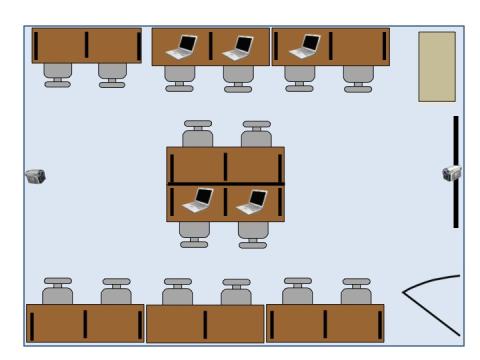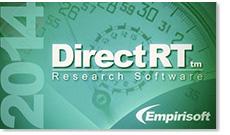
Welcome To The Behavioral Research Lab
The Behavioral Research Lab is a multidisciplinary lab for studying human behavior and decision-making. It is an important asset to Paul College, supporting our research mission by providing a sophisticated and controlled environment to facilitate the creation of scientific knowledge.
The Behavioral Research Lab has an expansive collection of equipment, hardware and software to allow for a wide variety of studies.
Contact Information
The Lab is equipped with the following:
- 16 17-inch laptop computers with mice and headphones
- 2 locking portable laptop storage and charging carts
- 8 large tables and 16 chairs (multiple configurations)
- Lightweight removable privacy partitions
- Internet (Wi-Fi and Ethernet)
- 2 mounted cameras and 2 microphones for live or recorded video and audio streaming to any networked computer
- Large flat panel LCD display (50 inches) mounted to wall
Room Set Up:
There are multiple options for room set up:


The following is a list of software currently available on the Lab computers, along with helpful links for using the software. If you would like to use a software program that is not listed below, please contact us.

MediaLab is a software package developed by Empirisoft for conducting multimedia experiments and questionnaires with a variety of response formats. No formal programming is required and it enables great flexibility for multimedia presentations. The program writes data to an ASCII file or imports files into Excel or SPSS.
- For an overview of general features, see the MediaLab website.
- The Online User’s Guide contains detailed instructions, samples, advanced feature and custom option descriptions, and tips and notes (also available as a PDF on their website).
- Visit Empirisoft Support to post questions, view questions and answers posted by others, and access experiment templates.

DirectRT is a software package by Empirisoft that allows for the creation of reaction time tasks requiring millisecond precision timing. It can run in conjunction with MediaLab or on its own. The software allows you to present precisely-timed text, images, audio and video clips and retrieve accurate, high-speed response input from keyboards, mice, joysticks, microphones and a variety of external hardware. Input and output files are saved in .CSV format and can be edited from Excel or other standard spreadsheet applications.
- For an overview of general features, see the DirectRT website.
- The Online User’s Guide contains detailed instructions and tutorials (also available as a PDF on their website).
- Visit Empirisoft Support to post questions, view questions and answers posted by others, and access experiment templates.

Qualtrics is a web-based tool for creating and administering surveys. It enables researchers to conduct survey-based experiments, including a randomization tool for experimental trials. UNH has a license for Qualtrics.
- Visit the Qualtrics University website to view detailed instructions by topic, search for specific questions, download eBook guides and access comprehensive online training videos.
- For support help, e-mail support@qualtrics.com or call 800-340-9194.

MATLAB is a high-level language for numerical computation, visualization and programming. Among its many features are built-in graphics for visualizing data and tools for building applications with custom graphical interfaces. It can be used to create experiments when used with Psychophysics Toolbox, a free set of extensions for MATLAB that enables precise stimulus display and response collection for vision research.
- The MATLAB website contains a wide range of resources. Click on the side tabs for short instructional videos, code examples and extended webinars.
- For detailed instructions on everything from language fundamentals to graphics, visit the MATLAB Documentation page.
- This MATLAB manual PDF also contains detailed instructions.
- The PsychToolbox Wiki page includes a tutorial, function reference, answers to FAQs, a user forum and a list of useful links.

OpenSesame is a free, open-source graphical experiment builder for psychology, neuroscience and experimental economics. Users can easily build experiments using a graphical user interface or code using Python scripting for more complex tasks.
- The OpenSesame homepage contains a great deal of useful resources for learning how to use OpenSesame, including instructions, video tutorials and sample experiments.
- The OpenSesame online forum allows users to post questions and view questions asked by others, which are answered by the software’s creators and other users.
- This journal article presents a general overview of OpenSesame and its features.

z-Tree (Zurich Toolbox for Readymade Economic Experiments) is a software package developed by Urs Fischbacher at the University of Zurich for designing and conducting economic experiments. Examples of possible experiments include public good experiments, structured bargaining experiments and auctions. The software package consists of the z-Tree program for controlling the experiment and the client program z-Leaf.
- For an overview of features, visit the z-Tree website.
- If you are having problems with z-Tree, e-mail the creators.
- This site by Ernesto Reuben includes instruction slides, sample z-Tree programs and general information on experimental economics.
- z-Tree Experimenters Manual
